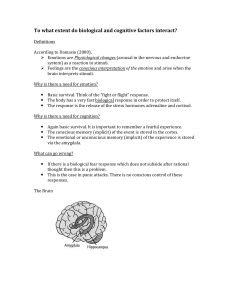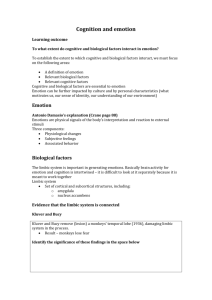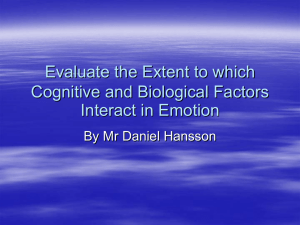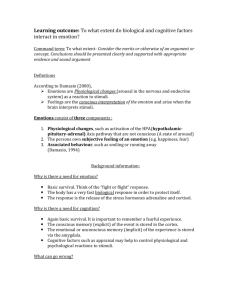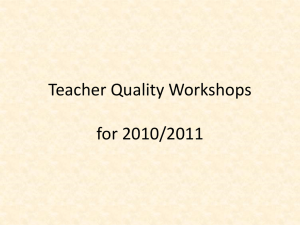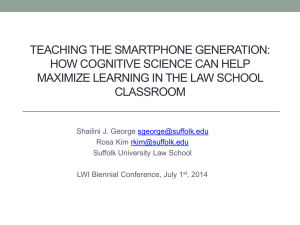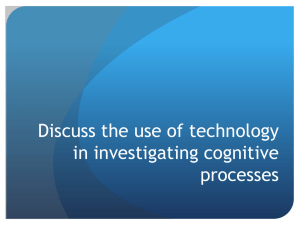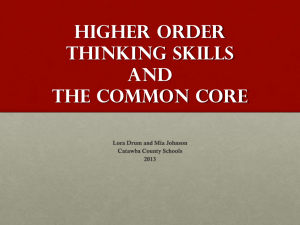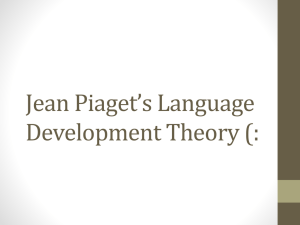Cognitive and Biological factors interact
advertisement
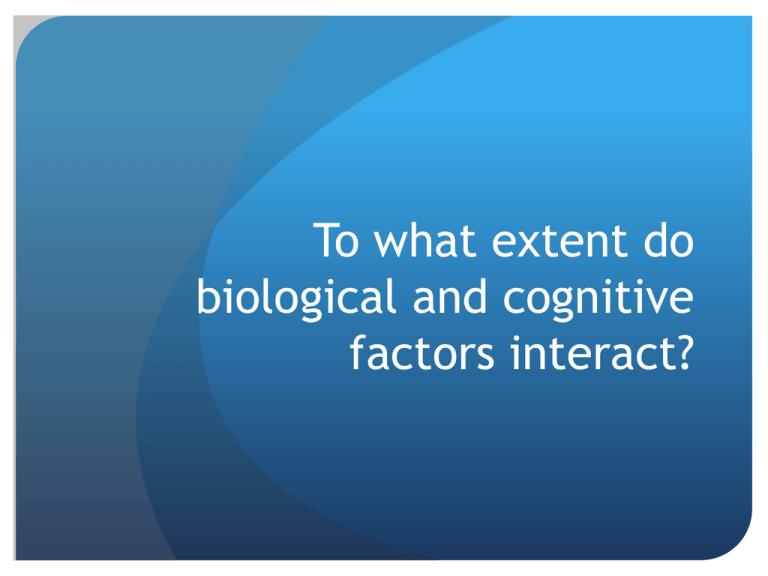
To what extent do biological and cognitive factors interact? Definitions According to Damasio (2000), Emotions are Physiological changes (arousal in the nervous and endocrine system) as a reaction to stimuli. Feelings are the conscious interpretation of the emotion and arise when the brain interprets stimuli. Why is there a need for emotion? Basic survival. Think of the “fight or flight” response. The body has a very fast biological response in order to protect itself. The response is the release of the stress hormones adrenaline and cortisol. Can you think of other emotions that have a biological basis? Why is there a need for cognition? Again basic survival. It is important to remember a fearful experience. The conscious memory (explicit) of the event is stored in the cortex. The emotional or unconscious memory (implicit) of the experience is stored via the amygdala. Why do the systems interact? If there is a biological fear response which does not subside after rational thought then this is a problem. This is the case in panic attacks. There is no conscious control of these responses. The Brain Biological and Cognitive interactions in the brain The Amygdala According to Phelps (2004) it helps in storing and classifying emotionally charged memories so that emotional events receive priority. It plays a large role in processing our emotions, especially fear. It's been found to trigger responses to strong emotion such as sweaty palms, freezing, increased heart-beat/respiration and stress hormone release. Humans with damage to the amygdala do not experience fear in dangerous situations Biological and Cognitive interactions in the brain The Hippocampus It's primary role is in memory formation (semantic and episodic), classifying information, long-term memory. Like the RAM in your computer it processes and stores new and temporary memory for long term storage. There are different theories about how cognitive and biological factors interact in emotion. LeDoux’s theory of the emotional brain Lazarus (1975) Appraisal theory LeDoux’s theory of the emotional brain Humans’ emotional reactions are flexible due to evolution. There is an instant response to detected danger for the purpose of survival (the short route). Humans have also evolved “emotional feeling” i.e a conscious experience of the emotion which helps to evaluate the level of danger before a response (the long route). LeDoux’s model Explaining the model The short route: Emotional stimulus is first processed in the thalamus, which sends a signal to the amygdala. The amygdala immediately activates response systems. Useful if there is immediate danger. AT THE SAME TIME The long route: The sensory input goes via the sensory cortex to the hippocampus for closer inspection. This involves evaluation of the stimulus and consideration of an appropriate response which is fed back to the amygdala. This links with the concept of cognitive appraisal, Lazarus 1975 Lazarus (1975) Appraisal theory This theory states that cognitive factors can control stress responses. Appraisal can be seen as an evaluation of a situation, including evaluation of one’s psychological and material resources to cope with a stressful event. People are psychological beings who are not simply passively responding to the world. Speisman et al (1964) Experimental manipulation of emotions through cognitive appraisal Aim: Can the manipulation of cognitive appraisal influence emotional experience? Method: Laboratory experiment. Participants were shown an anxiety evoking film (aboriginal initiation ceremony where boys were subjected to genital cutting). Speisman continued 3 different soundtracks were played to manipulate emotional reactions. Trauma condition, emphasized mutilation and pain Intellectualization condition, gave an anthropological interpretation of the ceremony. Denial condition, showed the boys being willing and happy in the ceremony Speisman continued During the viewing of the film, physiological measures were taken such as heart rate. Results: The trauma condition showed much higher physiological measures of stress. This shows that it is not the event itself that elicited the emotional stress, but the ‘appraisal’ of it. When the cognitive appraisal of a situation is manipulated (i.e. to be more traumatic), it influences emotion (the physiological stress response). Speisman evaluation +The study demonstrates how biological and cognitive factors interact. + Supports LeDoux’s theory in that cognitive appraisal involves the hippocampus. + Laboratory experiment with rigorous control to show cause and effect… BUT - Lacks ecological validity -Ethical issues of deception and psychological stress Summary of the interaction of emotion and cognition Cognitive and biological factors do, to a large extent, interact in emotion. However, the way they interact is complex and not fully understood. Emotions influence cognitive processes such as memory. Cognitive processes such as appraisal influence emotions. The physiology of emotion is not fully understood.
